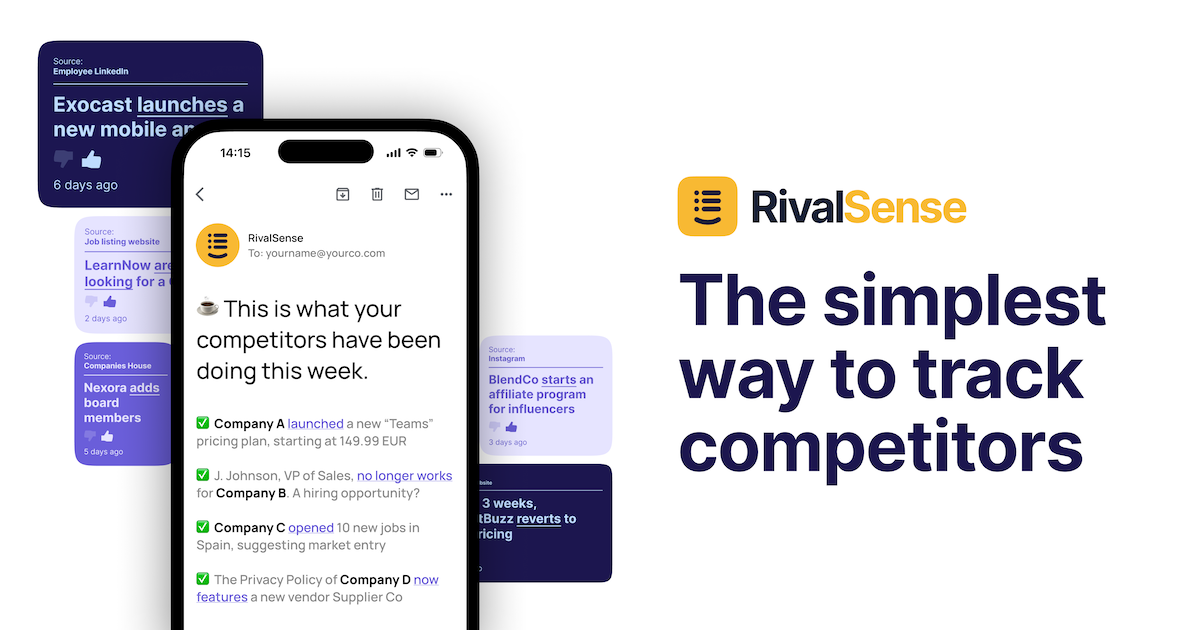- Strategy Models
- Posts
- The Dead Simple Easy Way to Track Competition in B2B
The Dead Simple Easy Way to Track Competition in B2B
Sometimes, the most effective starting point is right in front of you.
Learn What Fortune 500 Marketers Know

Ready to master marketing like the pros?
Subscribe to Masters in Marketing by HubSpot and get:
🏀 Exclusive stories from brands like the NBA and Oatly.
📚 Easy-to-digest tips you can act on today.
💡 Fresh ideas to elevate your next campaign.
Why wait? Join thousands of marketers getting smarter every week. Click to subscribe and start growing your impact now!
Feeling overwhelmed trying to dive into competitive intelligence for the first time?
Maybe you’re staring at a blank spreadsheet, unsure where to start, or wondering if you need fancy tools to get the ball rolling.
Here’s the truth: sometimes, the most effective starting point is right in front of you.
Let’s simplify competitive intel and simplify a straightforward approach to tracking your competition, one actionable step at a time.
Before diving into tools and tactics, hit pause. Ask yourself:
👉 What’s the specific question I’m trying to answer about my competitors?
This may feel broad initially, but narrowing your focus will help you take actionable steps. Here are a few jumping-off points:
What’s their market share?
Use revenue data and market size estimates to get a ballpark figure—You don’t need Gartner or expensive reports—just solid assumptions and math. Combine revenue data with market size estimates to get a ballpark figure.How do we stack up against their top value proposition?
Compare their messaging and features to yours. Are they highlighting areas where you dominate or places where you need to level up?Where do they compete with us?
Look at verticals, geographies, or customer segments. Are they dominating in a specific niche or expanding into new markets?
🧰 Tools and Tactics to Get Started
Once you know what you’re looking for, here’s how to gather insights without breaking a sweat:
1. Get the Inside Scoop
Sales Team Insights: Your sales team is on the front lines. Chat with 10-15 members of your GTM team to learn what they’ve heard during pitches. These conversations can reveal competitors’ strengths, pricing strategies, and even weaknesses.
Win/Loss Analysis: Interview buyers after deals—whether you won or lost. Find out which competitors they considered and why. Buyers’ perspectives are the most unbiased truth you’ll get.
2. Go Full Search Sleuth
Find Subdomains: Run
site:example.com -site:www.example.comto uncover hidden gems like subdomains.Locate Public Files: Search
site:example.com filetype:pdfcan reveal marketing docs, contracts, or even product roadmaps. Add juicy keywords like “confidential” for extra fun.
3. Open Source Intel
Review Sites: G2 and TrustRadius are treasure troves for learning what customers love—or hate—about your competitors.
Reddit and YouTube: Check Reddit and YouTube for raw, unfiltered feedback and product demos.
4. Attend Trade Shows and Conferences
Competitors often showcase their latest strategies at industry events. Visit their booth, grab collateral, and watch their presentations. You can glean valuable information about their target audience, messaging, and product updates.
5. Analyze Web Traffic
Use SimilarWeb to assess referral traffic and identify your competitor’s most active customers. Referral links often reveal partnerships, integrations, or even specific use cases they’re promoting.
🧩 Actionable Competitive Intelligence for B2B SaaS
Let’s connect the dots and see how you can use CI insights to outmaneuver competitors:
1. Identify Blind Spots
Your competitors’ value propositions often highlight gaps in your own offering. If they’re doubling down on a feature, ask: Why? Is it because your product doesn’t have it? Or because they’re trying to cover up a weakness?
2. Improve Messaging
Feedback from buyers and review sites can help refine your positioning. If competitors are claiming they’re “simpler” or “faster,” tailor your messaging to highlight specific advantages that counteract these claims.
3. Engage Your Buyers
Post-deal interviews are a goldmine for learning how you’re perceived against the competition. Your buyers are the strongest competitive signal you’ll get.
After a deal, conduct a win/loss interview to find out how competitors are perceived in the market and how your product is evaluated against theirs.
⚔️ Reader Challenge: Start Your Competitive Intel Sprint
Okay, let’s spice this post up with a bit of a challenge. Ready to dive in?
This week, pick one competitor and:
Google Them: Use the search tips above to dig up subdomains or juicy PDFs.
Talk to Sales: Grab 10 minutes with a rep and ask what they’re hearing in pitches.
Check Reviews: Spend a few minutes on G2 or TrustRadius to see what customers are saying.
You don’t need a 100-page strategy to get started—just curiosity and the right questions. Let’s go!
💡 Final Thoughts: Competitive Intelligence Made Simple
Tracking your competition doesn’t have to be overwhelming. By focusing on the specific insights you need and using simple tools and tactics, you can gather powerful intelligence that drives smarter decisions.
The best competitive strategies start with the basics—because sometimes, the simplest moves are the most effective.
Want more actionable Competitive Intel tips? Subscribe to Battlecard for weekly strategies to outmaneuver your competition.

